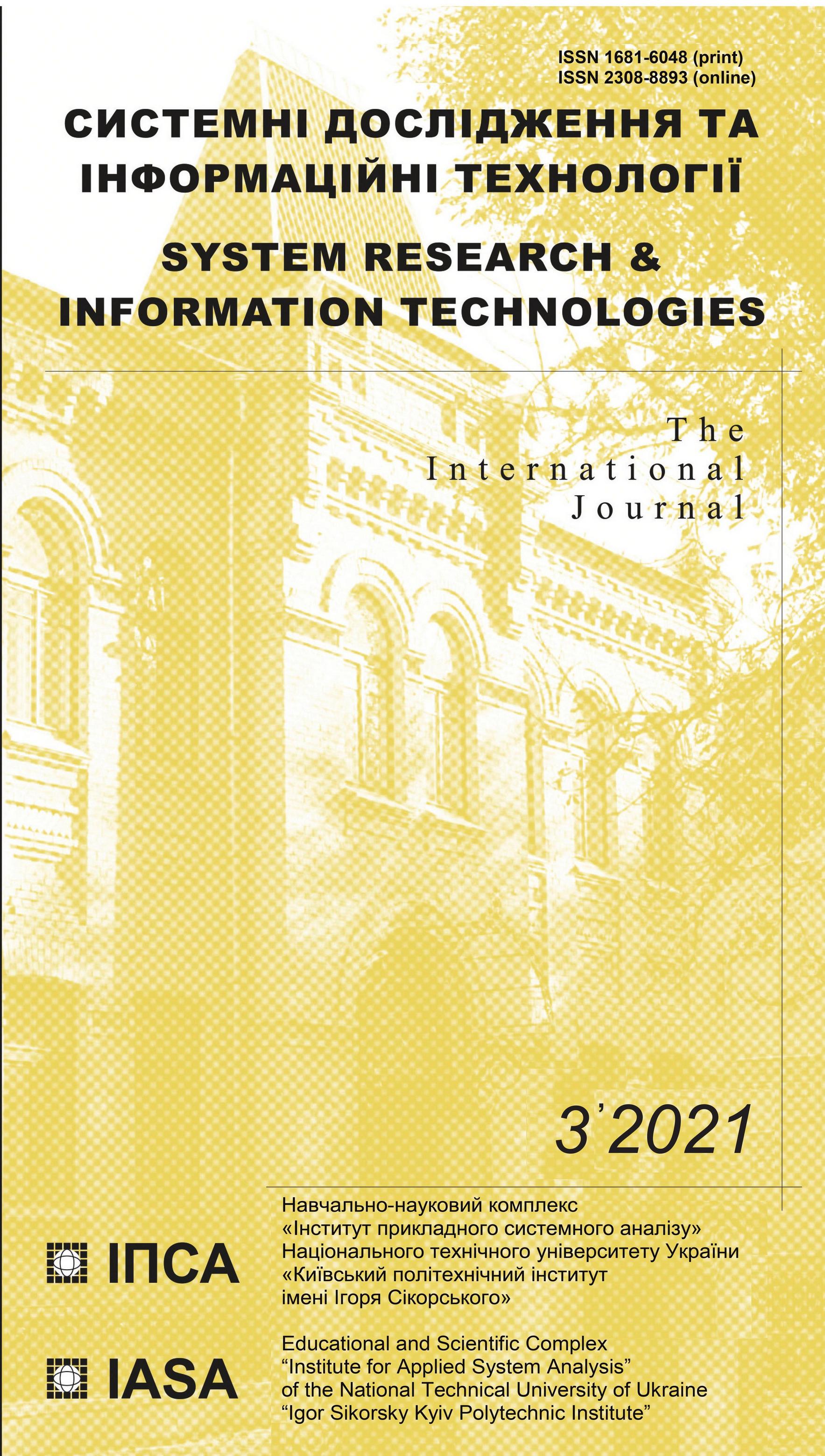Fuzzy logical conclusions and conclusions in expert systems of medical diagnostics
DOI:
https://doi.org/10.20535/SRIT.2308-8893.2021.3.05Keywords:
cluster analysis, multidimensional membership functions, centroids of fuzzy-sets of objects and clusters, centers of gravity and mid-sections of fuzzy sets, optimality criteria and clustering algorithmsAbstract
The main problems in making a correct diagnosis are: subjectivity and insufficient qualifications of the doctor, difficulties in correctly assessing the patient’s complaints, signs and symptoms of the disease observed in the patient, as well as individual manifestations of the symptoms of the disease. In publications on the use of expert systems for medical diagnostics using fuzzy logic, the main attention was paid to the medical features of the problem. In this work, for the first time, general methodological aspects of building such systems, creating databases, representing by fuzzy sets of real numbers, digital scales, linguistic and Boolean data of symptom values are formulated. The types of membership functions that are advisable to use to represent the symptoms of diseases are proposed. In fuzzy-logical conclusions, not only the values of the characteristic functions of the logical terms of individual symptoms, but also complex arithmetic functions of their values are used.
References
B.A. Kobrinsky, “Fuzziness in medicine and the need for its reflection in expert systems”, System of support for making medical decisions, no. 5, pp. 6–14, 2016.
B.A. Kobrinsky, B.V. Marjanchik, P.A. Temin, and A.Yu. Ermakov, “Application of the technology of virtual statistics for the development of a medical diagnostic system based on knowledge”, Intellectual and information systems in medicine. Collection of articles “Monitoring and decision support”. M.-Berlin: Direct-Media, 2016, pp. 21–36.
N.A. Korenovsky, “The use of fuzzy decision-making logic for medical expert systems”, Medical equipment, no. 1, pp. 33–35, 2015.
Yu.A. Zack, Making decisions in the face of blurry and fuzzy data. M.: URSS, 2013, 352 p.
A.B. Gogcharova, “Formulation of a preliminary medical diagnosis based on the theory of fuzzy sets using the Sugeno measure”, Bulletin of St. Petersburg State University. Applied math. Informatics, vol. 15, iss. 4, pp. 529–543, 2019.
N.A. Gudilina, E.S. Ivanova, A.V. Sibiryakov, N.V. Mekhonoshina, N.B. Rostova, and R.A. Faizrakhmanov, “The use of cluster analysis in the development of approaches to the selection and prescription of treatment regimens for HIV-infected patients”, Bulletin of Siberian Medicine, no. 16 (3), pp. 52–60, 2017.
V.A. Duke and D.I. Kurapeev, “Application of data mining methods to assess the risk of surgery in cardiac surgery”, Proceedings of SPIIRAS, no. 9, pp. 187–196, 2009.
S. Sridevi and S. Nirmala, “ANFIS based decision support system for prenatal detection of Truncus Arteriosus congenital heart defect”, Applied Soft Computing, no. 46, pp. 577–587, 2016.
M.A.M. Abushariah, A.A.M. Alqudah, O.Y.Adwan, and R.M.M. Yousef, “Automatic Heart Disease Diagnosis System Based on Artificial Neural Network (ANN) and Adaptive Neuro-Fuzzy Inference Systems (ANFIS) Approaches”, Journal of Software Engineering and Applications, no. 07(12), pp. 1055–1064. 2014.
O. Castillo, P. Melin, E. Ramirez, and J. Soria, “Hybrid intelligent system for cardiac arrhythmia classification with Fuzzy K-Nearest Neighbors and neural networks combined with a fuzzy system”, Expert Systems with Applications, vol. 39, iss. 3, pp. 2947–2955, 2012.
C. Loganathan and K.V. Girija, “Cancer Classification using Adaptive Neuro Fuzzy Inference System with Runge Kutta Learning”, International Journal of Computer Applications, 79(4), pp. 46–50, 2013.
E. Al-Daoud, “Cancer Diagnosis”, Using Modified Fuzzy Network, no. 2, pp. 73–78, 2010.
F.C. Fernandes, L.M. Brasil, J.M. Lamas, and R. Guadagnin, “Breast cancer image assessment using an adaptative network-based fuzzy inference system”, Pattern Recognition and Image Analysis, 20(2), pp.192–200, 2010.
H. Min, F.J. Manion, E. Goralczyk, Y.N. Wong, E. Ross, and J.R. Beck, “Integration of prostate cancer clinical data using an ontology”, Journal of Biomedical Informatics, vol. 42, no. 6, pp. 1035–1045, 2009.
S.M. Odeh, “Using an Adaptive Neuro-Fuzzy Inference System (ANFIS) Algorithm for Automatic Diagnosis of Skin Cancer”, Journal of Communication and Computer, no. 8, pp. 751–755, 2011.
M.I. Obayya, N.F. Areed, and A.O. Abdulhadi, “Liver Cancer Identification using Adaptive Neuro-Fuzzy Inference System”, International Journal of Computer Applications, 140(8), pp. 1–7, 2016.
P. Shanthakumar and P. Ganeshkumar, “Performance analysis of classifier for brain tumor detection and diagnosis, Computers & Electrical Engineering, 45, pp. 302–311, 2015.
P. Thirumurugan and P. Shanthakumar, “Brain tumor detection and diagnosis using ANFIS classifier”, International Journal of Imaging Systems and Technology, 26(2), pp. 157–162, 2016.
L.A. Gan Lim, R.N. Maguib, E.P. Dadios, and J.M.C. Avila, “Implementation of GA-KSOM and ANFIS in the classification of colonic histopathological images”, TENCON 2012 IEEE. Region 10 Conference, pp. 123–137.
E.D. Übeyli, “Automatic diagnosis of diabetes using adaptive neuro-fuzzy inference systems”, Expert Systems, 27(4), pp. 259–266, 2010.
E. El-Khamy, R.A. Sadek, and M.A. El-Khoreby, “An efficient brain mass detection with adaptive clustered based fuzzy C-mean and thresholding”, IEEE International Conference on Signal and Image Processing Applications, pp. 429–433, 2015.
B. Al-Naami, M. Abu Mallouh, and A.A. Kheshman, “Automated intelligent diagnostic of alzheimer disease based on neuro-fuzzy system and discrete wavelet transform”, Biomedical Engineering: Applications, Basis and Communications, 26(03), pp. 135–145, 2014.

